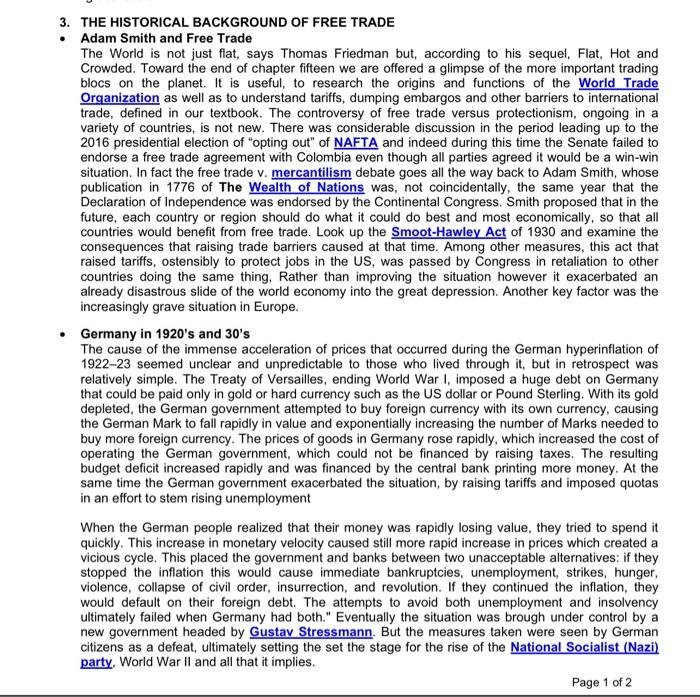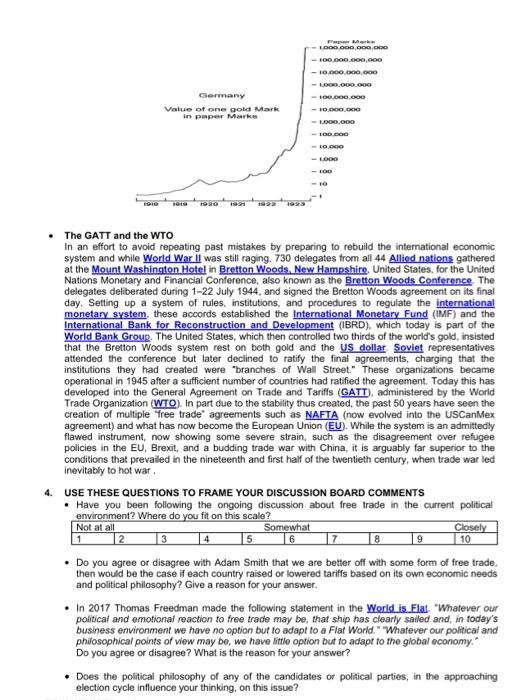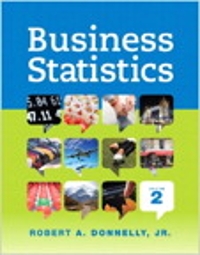Answered step by step
Verified Expert Solution
Question
1 Approved Answer
answer questions below 3. THE HISTORICAL BACKGROUND OF FREE TRADE - Adam Smith and Free Trade The World is not just flat, says Thomas Friedman
answer questions below 

3. THE HISTORICAL BACKGROUND OF FREE TRADE - Adam Smith and Free Trade The World is not just flat, says Thomas Friedman but, according to his sequel, Flat, Hot and Crowded. Toward the end of chapter fifteen we are offered a glimpse of the more important trading blocs on the planet. It is useful, to research the origins and functions of the World Trade Organization as well as to understand tariffs, dumping embargos and other barriers to international trade, defined in our textbook. The controversy of free trade versus protectionism, ongoing in a variety of countries, is not new. There was considerable discussion in the period leading up to the 2016 presidential election of "opting out" of NAFTA and indeed during this time the Senate failed to endorse a free trade agreement with Colombia even though all parties agreed it would be a win-win situation. In fact the free trade v. mercantilism debate goes all the way back to Adam Smith, whose publication in 1776 of The Wealth of Nations was, not coincidentally, the same year that the Declaration of Independence was endorsed by the Continental Congress. Smith proposed that in the future, each country or region should do what it could do best and most economically, so that all countries would benefit from free trade. Look up the Smoot-Hawley Act of 1930 and examine the consequences that raising trade barriers caused at that time. Among other measures, this act that raised tariffs, ostensibly to protect jobs in the US, was passed by Congress in retaliation to other countries doing the same thing, Rather than improving the situation however it exacerbated an already disastrous slide of the world economy into the great depression. Another key factor was the increasingly grave situation in Europe. Germany in 1920's and 30 's The cause of the immense acceleration of prices that occurred during the German hyperinflation of 1922-23 seemed unclear and unpredictable to those who lived through it, but in retrospect was relatively simple. The Treaty of Versailles, ending World War I, imposed a huge debt on Germany that could be paid only in gold or hard currency such as the US dollar or Pound Sterling. With its gold depleted, the German government attempted to buy foreign currency with its own currency, causing the German Mark to fall rapidly in value and exponentially increasing the number of Marks needed to buy more foreign currency. The prices of goods in Germany rose rapidly, which increased the cost of operating the German government, which could not be financed by raising taxes. The resulting budget deficit increased rapidly and was financed by the central bank printing more money. At the same time the German government exacerbated the situation, by raising tariffs and imposed quotas in an effort to stem rising unemployment When the German people realized that their money was rapidly losing value, they tried to spend it quickly. This increase in monetary velocity caused still more rapid increase in prices which created a vicious cycle. This placed the government and banks between two unacceptable alternatives: if they stopped the inflation this would cause immediate bankruptcies, unemployment, strikes, hunger, violence, collapse of civil order, insurrection, and revolution. If they continued the inflation, they would default on their foreign debt. The attempts to avoid both unemployment and insolvency ultimately failed when Germany had both." Eventually the situation was brough under control by a new government headed by Gustav Stressmann. But the measures taken were seen by German citizens as defeat, ultimately setting the set the stage for the rise of the National Socialist (Nazi) party. World War II and all that it implies. Page 1 of 2 - The GATT and the WTO In an effort to avoid repeating past mistakes by preparing to rebuild the international economic system and while World War II was still raging. 730 delegates from all 44 Allied nations gathered at the Mount Washington Hotel in Bretton Woods. New Hampshire. United States, for the United Nations Monetary and Financial Conference, also known as the Bretton Woods Conference. The delegates deliberated during 1-22 July 1944, and signed the Bretton Woods agreement on its final day. Setting up a system of rules, institutions, and procedures to regulate the international monetary system, these accords established the International Monetary Fund (IMF) and the International Bank for Reconstruction and Development (IBRD), which today is part of the World Bank Group. The United States, which then controlled two thirds of the world's gold, insisted that the Bretton Woods system rest on both gold and the US dollar Soviet representatives attended the conference but later declined to ratify the final agreements, charging that the instifutions they had created were "branches of Wall Street." These organizations became operational in 1945 after a sufficient number of countries had ratified the agreement. Today this has developed into the General Agreement on Trade and Tariffs (GATT), administered by the World Trade Organization (WTO). In part due to the stablity thus created, the past 50 years have seen the creation of multiple free trade* agreements such as NAFTA (now evolved into the USCanMex agreement) and what has now become the European Union (EU). While the system is an admittedly flawed instrument, now showing some severe strain, such as the disagreement over refugee policies in the EU, Brexit, and a budding trade war with China, it is arguably far superior to the conditions that prevaled in the nineteenth and first half of the twentieth century, when trade war led inevitably to hot war. 4. USE THESE QUESTIONS TO FRAME YOUR DISCUSSION BOARD COMMENTS - Have you been following the ongoing discussion about free trade in the current political anvirnnment? Where th vers fit on this srale? - Do you agree or disagree with Adam Smith that we are better off with some form of free trade. then would be the case if each country raised or lowered tariffs based on its own economic needs and political philosophy? Give a reason for your answer. - In 2017 Thomas Freedman made the following statement in the World is Flat. "Whatever our political and emotional reaction to free trade may be, that ship has clearly salled and, in today's business environment we have no option but to adapt to a Flat World. "Whatever our political and philosophical points of view may be, we have little option but to adapt to the global economy." Do you agree or disagree? What is the reason for your answer? - Does the political philosophy of any of the candidates or political parties, in the approaching election cycle influence your thinking, on this issue? 3. THE HISTORICAL BACKGROUND OF FREE TRADE - Adam Smith and Free Trade The World is not just flat, says Thomas Friedman but, according to his sequel, Flat, Hot and Crowded. Toward the end of chapter fifteen we are offered a glimpse of the more important trading blocs on the planet. It is useful, to research the origins and functions of the World Trade Organization as well as to understand tariffs, dumping embargos and other barriers to international trade, defined in our textbook. The controversy of free trade versus protectionism, ongoing in a variety of countries, is not new. There was considerable discussion in the period leading up to the 2016 presidential election of "opting out" of NAFTA and indeed during this time the Senate failed to endorse a free trade agreement with Colombia even though all parties agreed it would be a win-win situation. In fact the free trade v. mercantilism debate goes all the way back to Adam Smith, whose publication in 1776 of The Wealth of Nations was, not coincidentally, the same year that the Declaration of Independence was endorsed by the Continental Congress. Smith proposed that in the future, each country or region should do what it could do best and most economically, so that all countries would benefit from free trade. Look up the Smoot-Hawley Act of 1930 and examine the consequences that raising trade barriers caused at that time. Among other measures, this act that raised tariffs, ostensibly to protect jobs in the US, was passed by Congress in retaliation to other countries doing the same thing, Rather than improving the situation however it exacerbated an already disastrous slide of the world economy into the great depression. Another key factor was the increasingly grave situation in Europe. Germany in 1920's and 30 's The cause of the immense acceleration of prices that occurred during the German hyperinflation of 1922-23 seemed unclear and unpredictable to those who lived through it, but in retrospect was relatively simple. The Treaty of Versailles, ending World War I, imposed a huge debt on Germany that could be paid only in gold or hard currency such as the US dollar or Pound Sterling. With its gold depleted, the German government attempted to buy foreign currency with its own currency, causing the German Mark to fall rapidly in value and exponentially increasing the number of Marks needed to buy more foreign currency. The prices of goods in Germany rose rapidly, which increased the cost of operating the German government, which could not be financed by raising taxes. The resulting budget deficit increased rapidly and was financed by the central bank printing more money. At the same time the German government exacerbated the situation, by raising tariffs and imposed quotas in an effort to stem rising unemployment When the German people realized that their money was rapidly losing value, they tried to spend it quickly. This increase in monetary velocity caused still more rapid increase in prices which created a vicious cycle. This placed the government and banks between two unacceptable alternatives: if they stopped the inflation this would cause immediate bankruptcies, unemployment, strikes, hunger, violence, collapse of civil order, insurrection, and revolution. If they continued the inflation, they would default on their foreign debt. The attempts to avoid both unemployment and insolvency ultimately failed when Germany had both." Eventually the situation was brough under control by a new government headed by Gustav Stressmann. But the measures taken were seen by German citizens as defeat, ultimately setting the set the stage for the rise of the National Socialist (Nazi) party. World War II and all that it implies. Page 1 of 2 - The GATT and the WTO In an effort to avoid repeating past mistakes by preparing to rebuild the international economic system and while World War II was still raging. 730 delegates from all 44 Allied nations gathered at the Mount Washington Hotel in Bretton Woods. New Hampshire. United States, for the United Nations Monetary and Financial Conference, also known as the Bretton Woods Conference. The delegates deliberated during 1-22 July 1944, and signed the Bretton Woods agreement on its final day. Setting up a system of rules, institutions, and procedures to regulate the international monetary system, these accords established the International Monetary Fund (IMF) and the International Bank for Reconstruction and Development (IBRD), which today is part of the World Bank Group. The United States, which then controlled two thirds of the world's gold, insisted that the Bretton Woods system rest on both gold and the US dollar Soviet representatives attended the conference but later declined to ratify the final agreements, charging that the instifutions they had created were "branches of Wall Street." These organizations became operational in 1945 after a sufficient number of countries had ratified the agreement. Today this has developed into the General Agreement on Trade and Tariffs (GATT), administered by the World Trade Organization (WTO). In part due to the stablity thus created, the past 50 years have seen the creation of multiple free trade* agreements such as NAFTA (now evolved into the USCanMex agreement) and what has now become the European Union (EU). While the system is an admittedly flawed instrument, now showing some severe strain, such as the disagreement over refugee policies in the EU, Brexit, and a budding trade war with China, it is arguably far superior to the conditions that prevaled in the nineteenth and first half of the twentieth century, when trade war led inevitably to hot war. 4. USE THESE QUESTIONS TO FRAME YOUR DISCUSSION BOARD COMMENTS - Have you been following the ongoing discussion about free trade in the current political anvirnnment? Where th vers fit on this srale? - Do you agree or disagree with Adam Smith that we are better off with some form of free trade. then would be the case if each country raised or lowered tariffs based on its own economic needs and political philosophy? Give a reason for your answer. - In 2017 Thomas Freedman made the following statement in the World is Flat. "Whatever our political and emotional reaction to free trade may be, that ship has clearly salled and, in today's business environment we have no option but to adapt to a Flat World. "Whatever our political and philosophical points of view may be, we have little option but to adapt to the global economy." Do you agree or disagree? What is the reason for your answer? - Does the political philosophy of any of the candidates or political parties, in the approaching election cycle influence your thinking, on this issue 

Step by Step Solution
There are 3 Steps involved in it
Step: 1

Get Instant Access to Expert-Tailored Solutions
See step-by-step solutions with expert insights and AI powered tools for academic success
Step: 2

Step: 3

Ace Your Homework with AI
Get the answers you need in no time with our AI-driven, step-by-step assistance
Get Started


